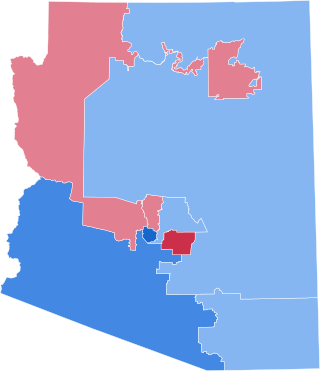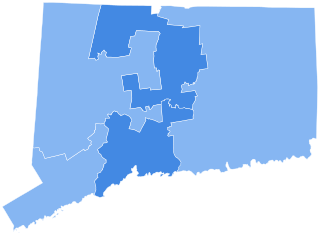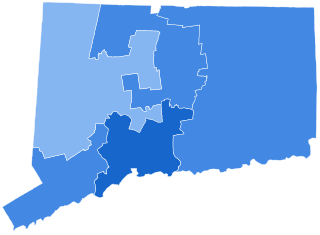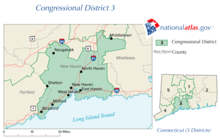
Connecticut is divided among five congressional districts from which citizens elect the state's representatives to the United States House of Representatives. After the re-apportionment following the 2000 census, Connecticut lost one representative, reducing the state's delegation from six to five. The redistricting process was shared between the Republican governor at the time, John G. Rowland, and the Democratic-controlled General Assembly. Before the census, the state's House delegation was split evenly between Republicans and Democrats, and the solution finally agreed upon by the redistricting committee would ensure an even match-up between incumbents, the 6th district's Nancy L. Johnson, a Republican, and the 5th district's James H. Maloney, a Democrat. In the 2002 elections, Johnson defeated Maloney by a surprisingly large margin in the new 5th district.

The 2008 Minnesota U.S. House of Representatives elections took place on November 4, 2008. All 8 congressional seats that make up the state's delegation were contested. Representatives were elected for two-year terms; those elected served in the 111th United States Congress from January 4, 2009 until January 3, 2011.

The 2008 United States House of Representatives elections in New York were held on November 4, 2008, to elect the 29 U.S. representatives from the State of New York, one from each of the state's 29 congressional districts. state of New York in the United States House of Representatives. New York has 29 seats in the House, apportioned according to the 2000 United States census. Representatives are elected for two-year terms; those elected will serve in the 111th Congress from January 4, 2009, until January 3, 2011. The election coincided with the 2008 U.S. presidential election in which Democrat Barack Obama defeated Republican John McCain by a wide margin.

The 2008 congressional elections in Arizona were held on November 4, 2008, to determine who would represent the state of Arizona in the United States House of Representatives, coinciding with the presidential election. Representatives are elected for two-year terms; those elected would serve in the 111th Congress from January 4, 2009, until January 3, 2011.

The 2008 United States House of Representatives elections in Arkansas were held on November 4, 2008 to determine who will represent the state of Arkansas in the United States House of Representatives. Arkansas has four seats in the House, apportioned according to the 2000 United States census. Representatives are elected for two-year terms; those elected will serve in the 111th Congress from January 4, 2009 until January 3, 2011. The election coincides with the 2008 presidential election.

The 2008 congressional elections in Colorado were held on November 4, 2008 to determine who will represent the state of Colorado in the United States House of Representatives, coinciding with the presidential and senatorial elections. Representatives are elected for two-year terms; those elected served in the 111th Congress from January 3, 2009 until January 3, 2011.

The 2008 congressional elections in Illinois were held on November 4, 2008 to determine who would represent the State of Illinois in the United States House of Representatives, coinciding with the presidential and U.S. Senate elections. Representatives are elected for two-year terms; those elected served in the 111th Congress from January 3, 2009 until January 3, 2011.

The United States House of Representative elections of 2008 in North Carolina were held on November 4, 2008, as part of the biennial election to the United States House of Representatives. All thirteen seats in North Carolina, and 435 nationwide, were elected to the 111th United States Congress. The party primary elections were held on May 6, 2008.

The 2008 congressional elections in Pennsylvania was held on November 4, 2008, to determine who will represent the state of Pennsylvania in the United States House of Representatives. Pennsylvania has 19 seats in the House, apportioned according to the 2000 United States census. Representatives are elected for two-year terms; those elected will serve in the 111th Congress from January 4, 2009, until January 3, 2011. The election coincides with the 2008 U.S. presidential election.

The 2008 congressional elections in Georgia were held on November 4, 2008, to determine who would represent the state of Georgia in the United States House of Representatives, coinciding with the presidential and senatorial elections. Representatives are elected for two-year terms; those elected will serve in the 111th Congress from January 3, 2009, until January 3, 2011.

The 2008 United States House of Representatives Elections in Florida were held on November 4, 2008 to determine who would represent the state of Florida in the United States House of Representatives. Representatives are elected for two-year terms; those elected served in the 111th Congress from January 4, 2009 until January 3, 2011. The election coincided with the 2008 U.S. presidential election.

The 2008 congressional elections in New Mexico were held on November 4, 2008 to determine New Mexico's representation in the United States House of Representatives. The party primary elections were held June 3, 2008. Martin Heinrich, Harry Teague, and Ben Ray Luján, all Democrats, were elected to represent New Mexico in the House. Representatives are elected for two-year terms; the winners of the election currently serve in the 111th Congress, which began on January 4, 2009 and is scheduled to end on January 3, 2011. The election coincided with the 2008 U.S. presidential election and senatorial elections.

The 2008 congressional elections in Tennessee was held on November 4, 2008, to determine who will represent the state of Tennessee in the United States House of Representatives. Tennessee has nine seats in the House, apportioned according to the 2000 United States census. Representatives are elected for two-year terms; the elected served in the 111th Congress from January 4, 2009, until January 3, 2011. In the 2008 elections, Tennessee elected 5 Democrats and 4 Republicans to the US House, as neither the Democratic nor the Republican Party gained any seats. The election coincided with the 2008 U.S. presidential election.

The 2008 United States presidential election in Connecticut took place on November 4, 2008, and was part of the 2008 United States presidential election. Voters chose seven representatives, or electors to the Electoral College, who voted for president and vice president.

The 2010 United States House of Representatives elections in Connecticut took place on Tuesday, November 2, 2010 to elect the five Congressional representatives from the state, one from each of the state's five Congressional districts. The elections coincided with the elections of other federal and state offices, including governor, U.S. Senate, and state legislature races.

The 2006 United States House of Representatives elections in Connecticut were held on November 7, 2006, to elect the five members of the U.S. House, one from each of the state's congressional districts, to represent Connecticut in the 110th Congress. The elections coincided with a state gubernatorial election and a U.S. Senate election, as well as with Congressional elections in other states.

Elections for state and federal offices for the 2010 election cycle in Connecticut, US, were held on Tuesday, November 2, 2010. Any necessary primary elections for the Republican and Democratic parties were held on Tuesday, August 10, 2010.

The 2012 U.S. House of Representatives elections in Connecticut were held on Tuesday, November 6, 2012, to elect the five congressional representatives from the state, one from each of the state's five congressional districts. The elections coincided with the elections of other federal and state offices, including a quadrennial presidential election, a U.S. Senate election, and state legislature races.

The 2020 United States House of Representatives elections in Connecticut was held on November 3, 2020, to elect the five U.S. representatives from the state of Connecticut, one from each of the state's five congressional districts. The elections coincided with the 2020 U.S. presidential election, as well as other elections to the House of Representatives, elections to the United States Senate and various state and local elections.

The 2022 United States House of Representatives elections in Connecticut were held on November 8, 2022, to elect the five U.S. representatives from the state of Connecticut, one from each of the state's five congressional districts. The elections coincided with the 2022 U.S. Senate race in Connecticut and the 2022 Connecticut gubernatorial election, as well as other elections to the House of Representatives, other elections to the United States Senate and various state and local elections.


























